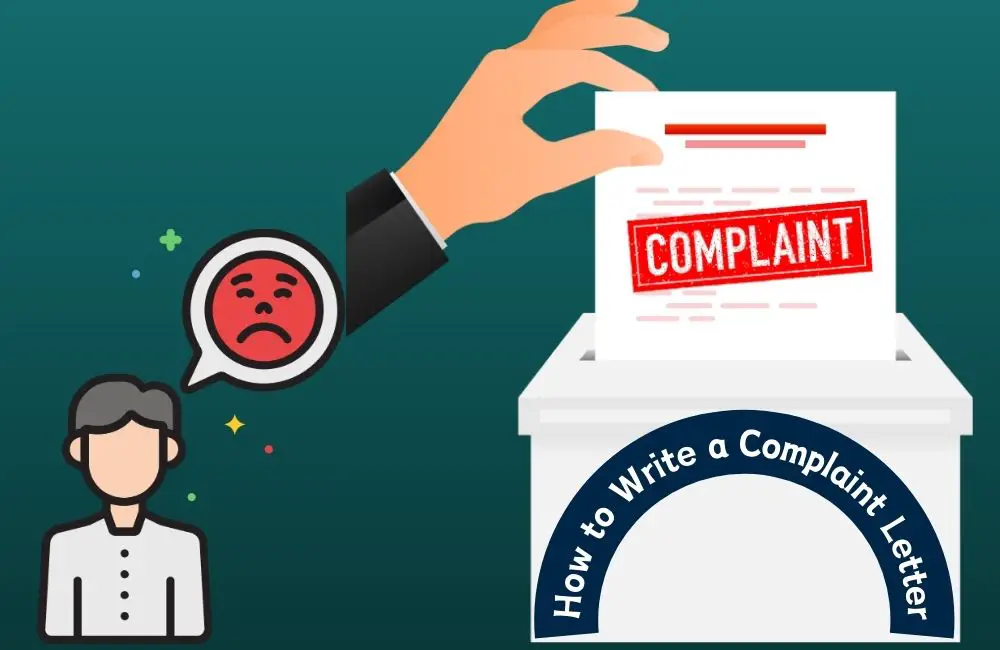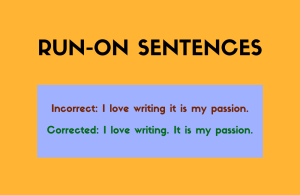This article covers the following areas
- Purpose of a Complaint Letter
- What to Do Before You Write?
- 1. Introductory Part of a Complaint Letter
- 2. Main Body of a Complaint Letter
- 3. Concluding Parts of a Complain Letter
- What to do after sending the letter?
- Tips to Make Your Letter Effective
- Final Words
- Test Your Learning – Quiz
- Frequently Asked Questions
Composing a complaint letter is essential for addressing dissatisfaction with a product or service professionally. This guide is designed to simplify the process, enabling you to articulate your concerns formally and effectively, even if you aim for a level of simplicity accessible to a younger audience.
To write a complaint letter, start with your personal details, then the date and recipient info. Politely state the issue, provide evidence, and specify a resolution. End with a willingness to engage, appreciation, and your signature.
For an in-depth guide on crafting an effective complaint letter, including examples and tips on follow-up, continue reading below.
Purpose of a Complaint Letter
A complaint letter is like sending a formal message when something you bought or a service you used didn’t make you happy. It’s a way to tell the company about your problem and ask them to fix it. This letter helps you explain what went wrong and what you want them to do, like giving your money back, replacing the item, or just apologizing.
The main goal of writing this letter is to get the company to pay attention to your issue and do something about it. It’s like raising your hand in class to let the teacher know you need help. By putting your complaint in writing, you make sure the company knows exactly what the problem is and how serious you are about wanting it solved.
When you write a complaint letter, you’re also keeping a record of your problem. This is important because it means you have proof of your complaint if you need to take more steps to resolve it. It’s like saving a receipt to show you bought the item or service if something goes wrong.
This kind of letter is powerful because it shows the company you’re serious and you understand your rights as a customer. It’s a respectful way to demand action and ensure companies listen to what you say. It’s all about standing up for yourself smartly and formally.
By sending a complaint letter, you’re also helping the company improve. Your feedback can show them where they need to improve so the same problem doesn’t happen to someone else. It’s a way to make things better for everyone, not just get your issue fixed.
What to Do Before You Write?
Before writing your complaint letter, take a deep breath and calm down. Writing with a clear head is important so your letter sounds logical, not just full of angry words. This way, you can make your point without letting emotions take over.
Next, make sure you have all your facts straight. Collect receipts, photos, emails, or anything else proving your point. It’s like gathering clues for a detective case; the more evidence you have, the stronger your case will be.
Then, consider what you want to happen after the company reads your letter. Do you want your money back, a new product, or an apology? Be clear about your goal, and ensure it’s something fair and makes sense. This helps the company understand exactly what you need to fix the problem.
1. Introductory Part of a Complaint Letter
When writing a complaint letter, the introduction sets the tone for the rest of your message. It’s like starting a conversation: You introduce yourself, explain who you’re talking to, and finally, get into the main discussion politely. Let’s break down how to do this step by step.
Personal Information
When writing a complaint letter, starting with your personal information is like laying down your ID card on the table. It’s your way of introducing yourself to the company. When you meet someone new, you start with your name; in a letter, you do the same but add more details. Write your full name, home address, phone number, and email in the top left corner.
For example, if Ananya Singh is writing, she’ll put this right at the start.
Ananya Singh
101 Rose Avenue, Kolkata, West Bengal, 700084
Phone: 9123456780
Email: [email protected]
This doesn’t just tell the company who Ananya is; it also shows them how to talk back to her. Ananya says, “Here’s how you can reach me if you want to fix this.”
By putting this information right at the start, Ananya ensures the company has everything they need to get back to her without looking elsewhere. It’s a smart move because it makes replying easier for them. Think of it as giving someone your address and phone number so they know where you live and how to call you.
This step is super important because it sets the stage for everything that follows in the letter. Without it, the company might not know who’s writing to them or how to respond. It’s the first step in ensuring your voice is heard, and your problem is taken seriously.
So, remember, whenever you’re writing a complaint letter, start by clearly stating who you are and how the company can contact you. It’s a simple but powerful way to open your letter, ensuring the company notices your words.
Date and Recipient’s Details
Just after you tell them who you are, the next step in your letter is like marking a spot on a timeline. By writing the date, you let the company know exactly when you contacted them. It’s like saying, “This is the day I decided to let you know something’s up.”
Placing the date at the top, right after your personal information, makes it easy to see and helps keep a record of your communication.
Ananya Singh
101 Rose Avenue, Kolkata, West Bengal, 700084
Phone: 9123456780
Email: [email protected]
March 10, 2024
Following the date, it’s time to make sure your letter gets to the right eyes and hands. Writing down the name and address of the company, or even better, a specific person if you know who to contact, is crucial. It’s similar to using GPS to navigate straight to where you need to go, avoiding detours.
For example, if you’re writing to TechGadgets Ltd., you’d specify the following right under the date –
Ananya Singh
101 Rose Avenue, Kolkata, West Bengal, 700084
Phone: 9123456780
Email: [email protected]
March 10, 2024
Attn: Customer Service TechGadgets Ltd.
234 Electronic City, Bengaluru, Karnataka, 560100
This part of your letter acts like a homing signal. It ensures that your message doesn’t just land anywhere but goes directly to the people who can help solve your problem.
Think of it as addressing a package; you want to ensure it arrives at the right doorstep, not just any doorstep in the neighborhood.
By carefully including the date and recipient’s details, you’re setting up your letter for a smooth journey from your hands to the right person’s desk. It’s all about making your message clear and getting it where changes can happen.
This step is like laying down a clear path for your words, ensuring they lead to action and, hopefully, a resolution to your issue.
Salutation
Greeting or saying hello in your complaint letter is more important than you might think. It’s like the first impression you make when you meet someone. Knowing the name of the person you’re writing to, starting with “Dear Ms. Iyer,” shows you’ve taken the time to personalize your message. It tells the reader, “I see you as someone who can help me.”
If you’re unsure who will read your letter, “Dear Customer Service” is a respectful and safe way to start. This greeting is like knocking on a door politely before entering. It shows you’re respectful and ready to engage in a constructive conversation, no matter who is on the other side.
Ananya Singh
101 Rose Avenue, Kolkata, West Bengal, 700084
Phone: 9123456780
Email: [email protected]
March 10, 2024
Attn: Customer Service TechGadgets Ltd.
234 Electronic City, Bengaluru, Karnataka, 560100
Dear Customer Service,
Choosing the right way to say hello sets a positive tone for the rest of your letter. It’s like starting a conversation on the right foot, making the reader more open to hearing what you say. A respectful greeting clarifies that you’re looking for a solution, not just a chance to complain.
So, the introductory part is crucial because it shows you’re approaching the issue with professionalism and respect. By clearly stating who you are, marking the date, addressing the recipient properly, and choosing the right salutation, you’re setting the stage for a constructive dialogue. It’s about making a good first impression and opening the door to a positive resolution.
2. Main Body of a Complaint Letter
The body of your complaint letter is where you really get down to business. This is where you explain what went wrong and what you want to be done about it. Let’s walk through how to lay out your concerns clearly and respectfully, following the format you provided.
Opening Statement
Start with why you’re writing. It’s like telling the company, “Here’s what’s up.” Briefly mention what you bought or the service you used, and pinpoint the problem. Keep it simple and to the point. For example, Ananya might write:
I am writing to express my dissatisfaction with the smartphone model X500 I purchased from your store in Electronic City, Bengaluru, on March 1, 2024. Unfortunately, the device has not been functioning properly since the day I bought it.
This opening is Ananya’s way of saying, “This is the issue I’m facing.”
Detailed Account
Next, it’s time to share the story of what happened. Think of this as giving directions; you want to be clear. Mention when and where you bought the product or service and what went wrong. If you’ve tried to fix the problem, mention that too. Remember, stick to the facts. Ananya could elaborate like this:
Despite following all setup instructions, the smartphone’s screen freezes repeatedly, and the battery drains within hours. I visited your service center on March 5, 2024, but the issue persists after the attempted repair.
This part is Ananya clearly mapping her experience without letting emotions steer the narrative.
Resolution Request
Now, what do you want the company to do? This is like telling them, “Here’s how you can make things right.” Be clear about whether you want a refund, a replacement, a repair, or just an apology. Ananya’s request might look like this:
Given the ongoing issues and the inconvenience caused, I kindly request a full refund or an exchange for a model that does not have these problems. I believe this is a fair request under the circumstances.
This is Ananya setting her destination, saying, “This is where I hope we can end up.”
So, once I put these three parts together, you will find something like,
Ananya Singh
101 Rose Avenue, Kolkata, West Bengal, 700084
Phone: 9123456780
Email: [email protected]
March 10, 2024
Attn: Customer Service
TechGadgets Ltd.
234 Electronic City, Bengaluru, Karnataka, 560100
Dear Customer Service,
I’m writing to let you know I’m not happy with the portable speaker (Model X123) I bought from your store on February 20, 2024. It hasn’t worked right since I got it, which is really disappointing.
Right from the start, the sound was bad, and it kept losing its Bluetooth connection. I tried fixing it with your manual and even emailed your support team on February 25, 2024, but nothing worked. By March 5, 2024, it wouldn’t even turn on.
I’m asking for a full refund of ₹5,000 or a new speaker that works as it should. I think that’s fair, given all the trouble I’ve had.
By structuring the body of your complaint letter this way, you’re guiding the company through your experience and toward a resolution. It’s about being clear, factual, and fair, laying out a path to a satisfactory outcome for both parties. This approach effectively communicates your concerns and shows you’re seeking a reasonable solution.
3. Concluding Parts of a Complain Letter
Concluding a complaint letter on the right note is as crucial as the complaint itself. It’s your final chance to leave a lasting impression and nudge the recipient towards a favorable outcome. Let’s break down how to craft a compelling conclusion.
Willingness to Engage
Start by showing you’re open to working together to solve the problem. This doesn’t just show you’re reasonable; it also suggests you’re looking for a win-win solution, not just airing grievances.
For example, you could write,
I am eager to discuss this further and find a solution that suits us both.
This line signals your readiness to engage in a dialogue, making it clear you’re not just complaining but are also part of the solution.
Appreciation
Next, a thank you goes a long way. Ending your letter by thanking the recipient for their time and attention reinforces the professional and respectful tone you’ve maintained throughout.
You might say –
Thank you for considering my concerns.
This simple gesture of appreciation acknowledges the effort it takes to address your complaint and helps maintain a positive relationship with the recipient.
Closure
Finally, sign off your letter formally to match the tone of your opening. A simple “Sincerely” followed by your name does the job. It’s like the closing handshake after a meeting—polite and expected.
For instance,
Sincerely,
Ananya Singh.
This formal closure marks the end of your letter and wraps up your communication on a respectful note.
Now, Let’s see how it looks like once I put all the parts together –
Ananya Singh
101 Rose Avenue, Kolkata, West Bengal, 700084
Phone: 9123456780
Email: [email protected]
March 10, 2024
Attn: Customer Service
TechGadgets Ltd.
234 Electronic City, Bengaluru, Karnataka, 560100
Dear Customer Service,
I’m writing to let you know I’m not happy with the portable speaker (Model X123) I bought from your store on February 20, 2024. It hasn’t worked right since I got it, which is really disappointing.
Right from the start, the sound was bad, and it kept losing its Bluetooth connection. I tried fixing it with your manual and even emailed your support team on February 25, 2024, but nothing worked. By March 5, 2024, it wouldn’t even turn on.
I’m asking for a full refund of ₹5,000 or a new speaker that works as it should. I think that’s fair, given all the trouble I’ve had.
I am eager to work together to find a satisfactory solution to this issue and am open to any suggestions you might have. Your prompt attention to this matter would be greatly appreciated, and I am willing to provide any further information needed.
Thank you very much for considering my request and for your time in addressing my concerns. I look forward to your response and am hopeful for a positive resolution.
Sincerely,
Ananya Singh
By incorporating these elements into the conclusion of your complaint letter, you effectively communicate your willingness to find a resolution, show gratitude for the recipient’s time, and maintain a professional demeanor. This approach leaves a good impression and increases the likelihood of a positive response.
What to do after sending the letter?
After you send off your complaint letter, giving the company time to get back to you is important. Think of it like planting a seed; you must wait before seeing it sprout. Usually, waiting a couple of weeks is a good rule of thumb. This shows you’re patient and understand that solving problems can take a little time.
While you’re waiting, keep a copy of the letter you sent and any replies you get. It’s like keeping a diary of your conversation with the company. This way, if you need to refer back to what was said or if you need to take further steps, you have all the information handy.
If those few weeks pass and you haven’t heard back, it’s time to follow up. This doesn’t mean bombarding them with messages every day. Instead, send a polite email or phone call asking if they received your letter and how the issue is being addressed. Letting them know you’re still waiting and expect a resolution is a gentle nudge.
Remember, staying calm and collected throughout the process is the key here. Getting angry or impatient won’t help solve the problem any faster. By following these steps, you’re doing everything right on your end to get the issue resolved.
Tips to Make Your Letter Effective
Crafting an effective complaint letter is an art that requires balance, clarity, and a touch of diplomacy. Whether you’re disappointed with a service, product, or experience, expressing your concerns formally is a vital step toward resolution. To help you navigate this process, here are some essential tips to consider:
1. Start With Clarity
Starting with clarity is crucial. Your letter should begin with a concise statement of its purpose. Clearly and succinctly explain the issue, avoiding extraneous details that might muddle your main points. This helps the recipient immediately grasp your complaint’s essence, setting a focused tone for the rest of your communication.
2. Maintain Professionalism
Maintaining professionalism throughout your letter cannot be overstated. Regardless of your frustration or disappointment, keeping the tone respectful and professional is essential. A polite and measured approach is far more likely to elicit a constructive response from the recipient, fostering an atmosphere conducive to resolving the issue.
3. Detail Specifics
Detailing specifics is vital for context and clarity. Include all relevant information, such as dates, locations, and specific details about the transaction or product. These specifics help the recipient understand the issue more thoroughly and demonstrate the seriousness of your complaint.
4. Explicitly State Your Expectation
Explicitly stating your expectations for resolution makes it easier for the company to address your concerns. Whether you’re seeking a refund, repair, replacement, or simply an apology, clarity about your desired outcome removes ambiguity and helps guide the company’s response to your satisfaction.
5. Attach Supporting Evidence
Attaching supporting evidence to your complaint strengthens your case. This could include receipts, warranties, email correspondences, or photographs related to your complaint. Such evidence provides tangible proof of your claims, making it harder for the recipient to overlook or dismiss your concerns.
6. Reference Previous Attempts
Referencing previous attempts to resolve the issue through customer service is also important. This shows that you have made a reasonable effort to address the problem through available channels, underscoring your commitment to finding a resolution.
7. Retain Copies of Correspondence
Retaining copies of all correspondence related to your complaint, including the letter and any responses, is crucial. This documentation may prove invaluable if the issue escalates or further action is required as a detailed record of your attempts to seek resolution.
8. Be Prepared to Follow Up
Finally, be prepared to follow up if you do not receive a response within a reasonable timeframe. A polite reminder can sometimes be necessary to prompt action. Persistence and a respectful approach can be key to achieving your desired resolution.
Incorporating these tips into your complaint letter ensures your communication is heard and taken seriously. The aim is not just to voice dissatisfaction but to initiate a constructive dialogue that leads to a satisfactory resolution. With the right approach, your letter can be a powerful tool in achieving your desired outcome.
Final Words
This guide outlines a structured approach to writing a complaint letter, emphasizing the importance of clarity, formality, and focus on resolution. By adhering to these guidelines, you can communicate your concerns effectively, facilitating a positive outcome.
Writing a complaint letter doesn’t have to be a daunting task. By following these steps and keeping your communication clear, polite, and to the point, you increase your chances of resolving your issue satisfactorily. Remember, the goal is not just to complain but to seek a fair solution for both parties involved.
Test Your Learning – Quiz
Frequently Asked Questions
A complaint letter is a written document sent to address issues with a product, service, or situation. It aims to resolve problems by informing the relevant party of the dissatisfaction and seeking a remedy.
A complaint letter should start with a polite greeting and a clear statement of the purpose. Begin by briefly explaining the issue and mentioning any relevant details like dates and names.
A complaint letter should include details like the date of the incident, the names of involved parties, a clear description of the problem, and any supporting evidence like receipts or photos. This helps in understanding and resolving the issue.
Express dissatisfaction in a complaint letter by clearly stating the problem and its impact. Use polite and respectful language, focusing on facts rather than emotions to maintain a constructive tone.
A complaint letter should request a specific action or solution to resolve the issue. This could be a refund, replacement, or an apology. Clearly state what is expected to help the recipient understand and act accordingly.
End a complaint letter by thanking the recipient for their time and consideration. Provide contact information and express hope for a prompt resolution. This leaves a positive impression and encourages a quicker response.
A complaint letter should use a polite and respectful tone. Avoid aggressive or confrontational language. This helps in maintaining a constructive dialogue and increases the chances of a positive outcome.
It is important to keep a copy of a complaint letter for reference. This provides evidence of the complaint and can be useful if further action is needed. It also helps in tracking the resolution process.
Common mistakes to avoid in a complaint letter include being overly emotional, vague descriptions, and not providing enough details. Stick to facts, be clear, and provide all necessary information to help resolve the issue effectively.
A complaint letter should be concise and to the point, ideally one page long. Include all necessary details without unnecessary information. This makes the letter easier to read and increases the chances of a quick response.







